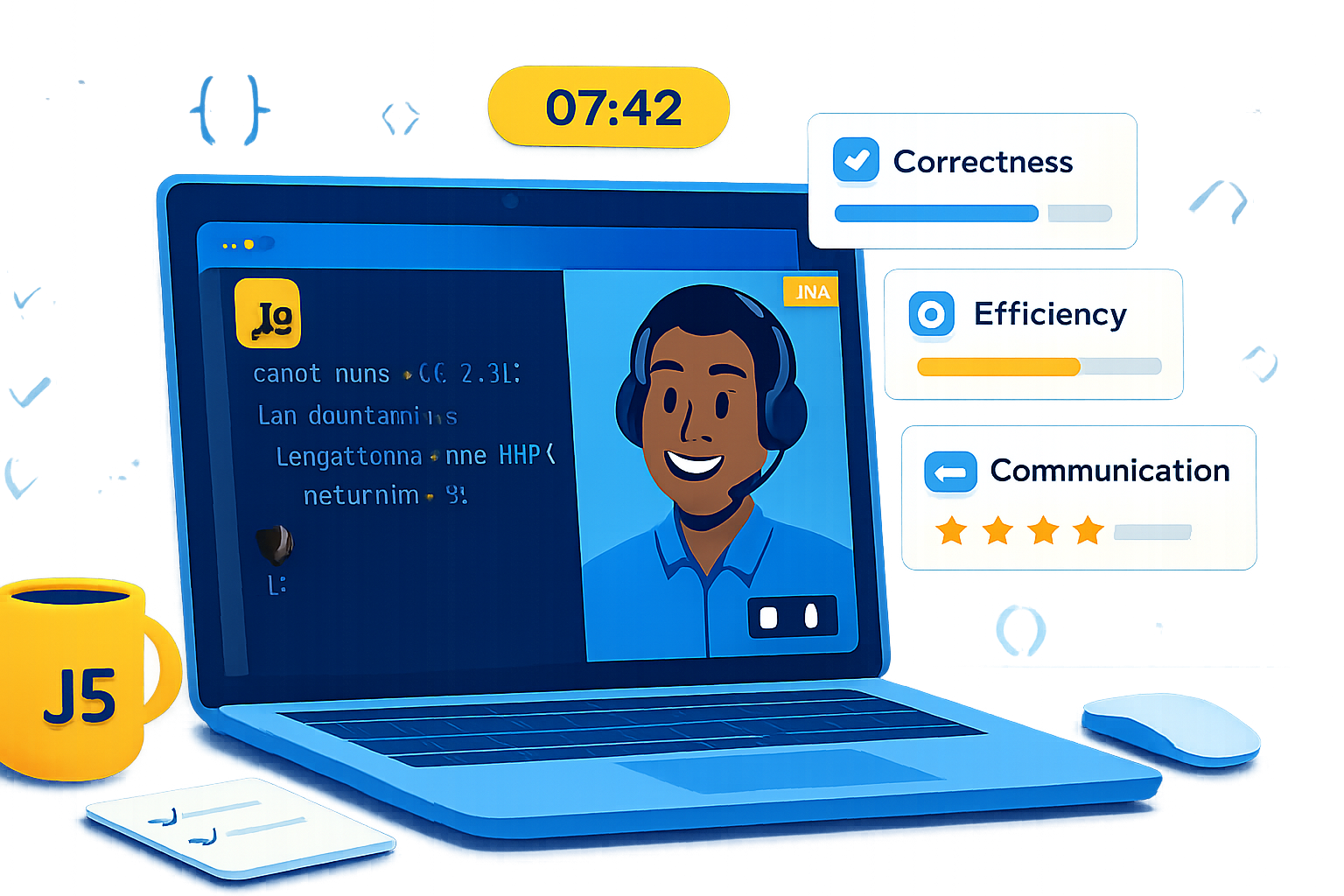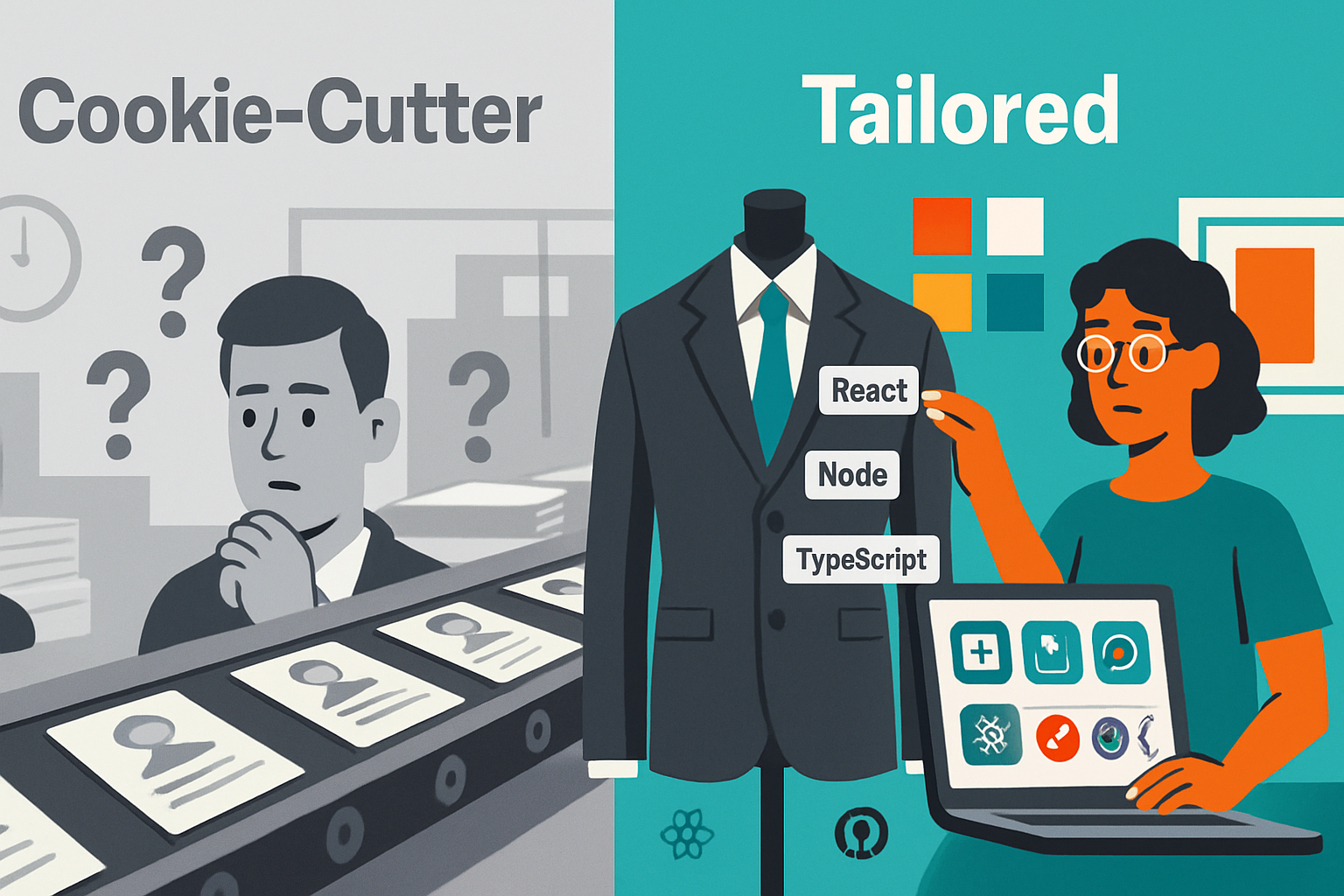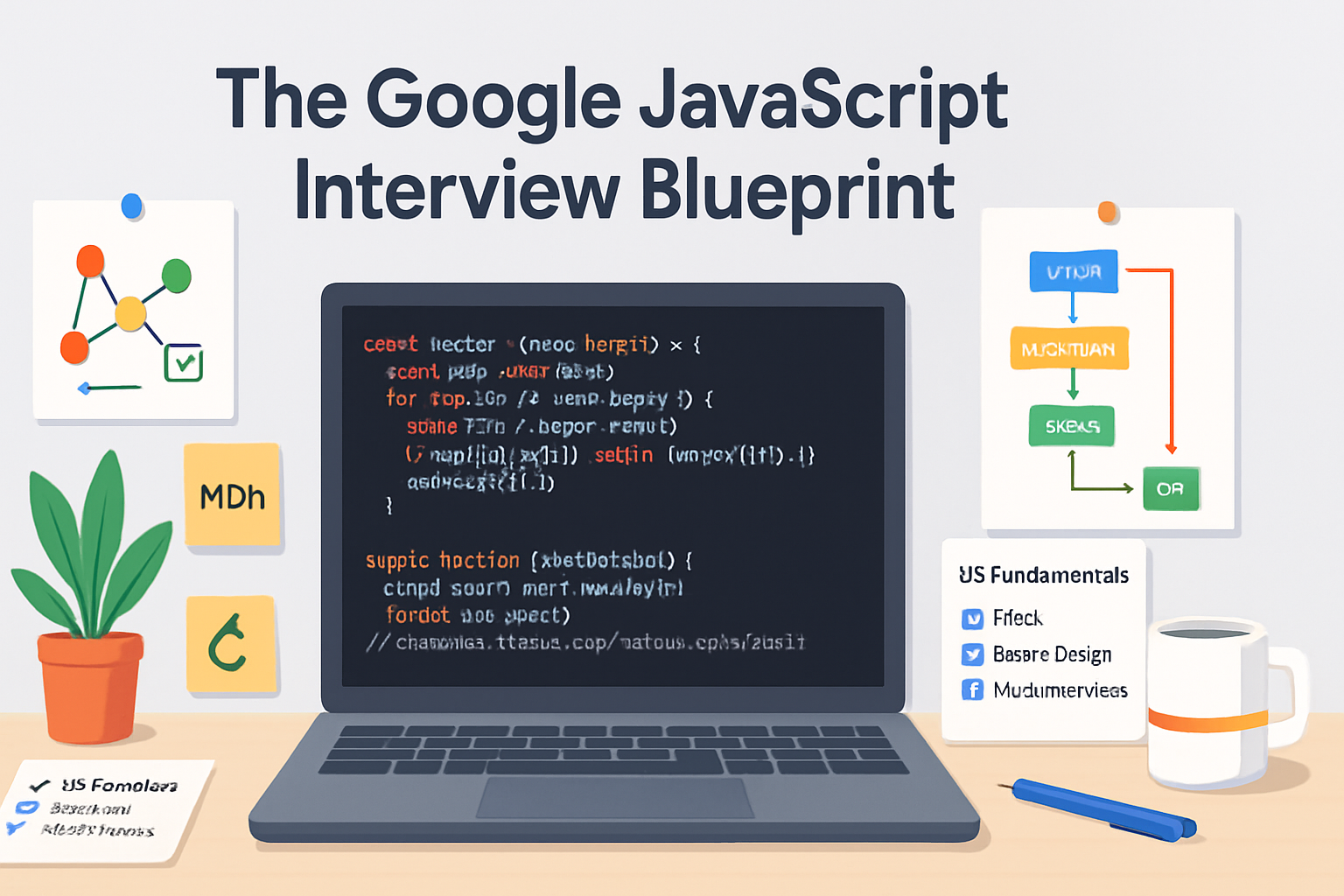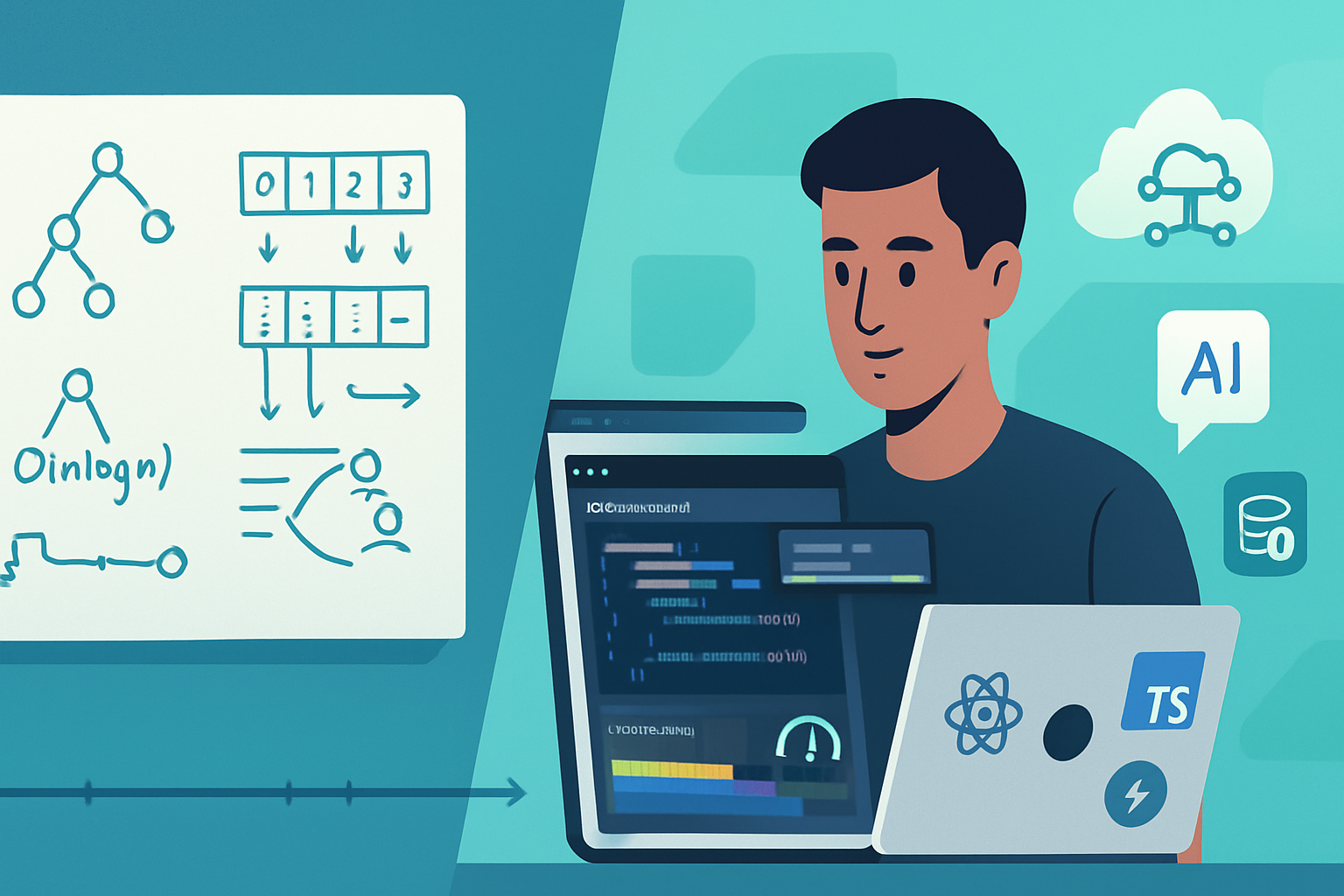· career · 7 min read
The Ultimate Guide to Mock Interviews for JavaScript Engineers: From Beginner to Pro
A complete playbook for JavaScript engineers to run effective mock interviews: formats, partner selection, scripts, question sets (beginner → pro), feedback rubrics, common pitfalls, and a 6-week practice plan to level up fast.

What you’ll get out of this guide
You want to walk into a JavaScript interview confident, clear, and convincing. This guide gives you a repeatable system to get there. Read it and you’ll know how to design mock interviews that actually move the needle - the exact formats to use, how to choose practice partners, what to say and what to avoid, scripts for mock sessions, immediate feedback templates, and a realistic 6-week roadmap from beginner to pro.
Short version: practice deliberately, get precise feedback, iterate fast. Do that and interviews become manageable instead of terrifying.
Why mock interviews work (and why most fail)
Mock interviews simulate the pressure, constraints, and social dynamics of real interviews - which trains you cognitively (problem-solving under time), technically (applying concepts), and socially (clear communication). But many practice sessions fail because they’re unfocused:
- No measurable goals.
- Feedback is vague or missing.
- The partner is unprepared or gives solutions too quickly.
- You only practice one format (e.g., LeetCode solo) and ignore behavioral or architecture questions.
Effective mocks require structure. That’s what this guide gives you.
Mock interview formats and when to use each
Pick the format based on the real interview you’re preparing for. Mix formats across your practice schedule.
- Live pair-programming (video + shared editor)
- Use when preparing for on-site, take-home, or remote pair-programming loops.
- Tools: VS Code Live Share, CodeSandbox, CodePen, [CoderPad], Zoom/Meet.
- Whiteboard-style (no running code)
- Best for algorithmic clarity and communication practice. Forces rigorous thought before typing.
- Take-home / project review
- Use for product engineering roles where take-home tasks and code reviews matter.
- Behavioral & system-design mock
- Practice storytelling (STAR) and high-level trade-offs. Use for senior roles and system design interviews.
- Platform-based mocks
- Use services like [Pramp] and [interviewing.io] for timed, anonymous practice with peers or engineers from FAANG-level companies.
Links: LeetCode: https://leetcode.com, Pramp: https://www.pramp.com, interviewing.io: https://interviewing.io
Who should you practice with? Choosing the right partner
Not all partners are equal. Choose based on your goal:
- Peer (similar level)
- Pros: affordable, comfortable, reciprocal feedback.
- Best for: early-stage practice, building habits, shared learning.
- Senior/mentor (in industry)
- Pros: deep domain knowledge, realistic feedback, hiring perspective.
- Best for: final polishing, resume-specific questions, role fit.
- Professional coach/interviewer
- Pros: structured sessions, focused feedback, interview-style questions.
- Best for: when you can’t break through plateaus or need mock interviews that mimic top-tier companies.
- Platform partners (Pramp, interviewing.io)
- Pros: anonymity, diversity of problems, timed sessions.
- Best for: simulating live interview pacing and stress.
Criteria checklist for a good partner:
- Shows up on time and prepared.
- Knows the format and rules (e.g., no immediate solution dumps).
- Gives both positive notes and actionable improvements.
- Can role-play interviewer behavior (interrupting, time reminders).
How to structure a 45–60 minute mock interview
Use this template to keep sessions high-leverage. Adjust durations to fit the real interview length.
- 5 minutes - Setup & expectations
- Confirm format, tools, time, and the role you’re simulating.
- 30–35 minutes - Problem solving / coding
- Candidate clarifies constraints, outlines approach, writes code, and tests edge cases.
- 5–10 minutes - Follow-up questions or optimizations
- Interviewer asks “what if” scenarios; candidate discusses trade-offs.
- 10 minutes - Feedback & reflection
- Use a concrete rubric. Candidate summarizes what they learned and commits to 1–2 improvements before next mock.
Tip: timebox strictly. Practice performing under time pressure.
What to practice at each level: beginner → pro
Beginner (0–6 months JS experience)
- Focus: fundamentals, syntax, arrays/objects, basic DOM, small algorithms.
- Sample tasks:
- Implement array unique, flatten, or a simple debounce function.
- DOM manipulation: create dynamic list, handle events.
- Soft skills: explain every step, think aloud.
Intermediate (6 months–3 years)
- Focus: data structures, closures, async/await, API patterns, common algorithms (two pointers, sliding window, hash maps).
- Sample tasks:
- Implement LRU cache interface in JS.
- Write a function to find all anagrams in a string.
- Soft skills: articulate time/space complexity, discuss trade-offs.
Pro (3+ years / senior)
- Focus: system design (frontend architecture), performance, advanced patterns, distributed considerations, design patterns.
- Sample tasks:
- Design a client-side caching strategy for offline-first web apps.
- Optimize a rendering pipeline for large lists (virtualization).
- Soft skills: lead the conversation, ask right questions, mentor the interviewer if needed.
Concrete mock interview scripts
Use these scripts to run real sessions.
Script A - Algorithm (45 minutes)
- 0–5 min: Interviewer reads prompt. Candidate paraphrases requirements and asks clarifying Qs.
- 5–10 min: Candidate sketches approach and complexity.
- 10–30 min: Candidate implements solution; writes tests / example cases.
- 30–35 min: Interviewer asks an optimization “what if” question.
- 35–45 min: Feedback and rubric review.
Script B - Frontend pair-programming (60 minutes)
- 0–5 min: Setup CodeSandbox and requirements (UX, edge cases, performance constraints).
- 5–20 min: Candidate outlines architecture (components, state management).
- 20–45 min: Candidate implements core feature; interviewer occasionally asks clarifying questions or simulates PI review.
- 45–55 min: Candidate adds tests and discusses accessibility/performance.
- 55–60 min: Feedback and next steps.
Example questions by level
Beginner
- Implement a function to remove duplicates from an array.
- Write a simple debounce function in JavaScript.
Intermediate
- Given an array of integers and target sum, return indices of two numbers that add to target (classic Two Sum). Explain complexity.
- Given an interval list, merge overlapping intervals.
Advanced / Senior
- Design a real-time collaborative text editor (high level).
- Optimize rendering for a feed with thousands of items: discuss virtualization, memoization, and reconciliation.
Live example: debounce implementation (good interview answer)
Explain then implement. First, state the problem: “Debounce delays invoking a function until after wait milliseconds have elapsed since the last time it was invoked.” Then outline edge cases: leading/trailing invocation, cancellation, and proper this binding.
function debounce(fn, wait = 100) {
let timer = null;
return function (...args) {
const context = this;
clearTimeout(timer);
timer = setTimeout(() => fn.apply(context, args), wait);
};
}
// Example usage:
// const debounced = debounce(() => console.log('called'), 200);
// window.addEventListener('resize', debounced);Explain complexity (O(1) per call), correctness, and how you’d test it (use fake timers or manual checks).
How to give and receive feedback (rubric & examples)
Feedback must be specific, timely, and actionable. Use a short rubric with scores 1–5.
Sample rubric (score each 1–5):
- Problem understanding: paraphrased requirements and clarified constraints.
- Communication: thinks aloud, explains trade-offs, handles interruptions.
- Solution design: correctness and simplicity.
- Code quality: naming, modularity, edge cases, tests.
- Complexity awareness: time/space analysis and optimizations.
Example written feedback snippet:
- Problem understanding: 4 - good paraphrase; missed runtime memory constraint.
- Communication: 3 - explained main steps but rarely verbalized while coding.
- Solution design: 4 - correct and readable.
- Code quality: 3 - needs more tests for edge cases and one helper could be extracted.
- Complexity: 5 - clear time/space analysis.
Action items for next mock:
- Practice thinking aloud for first 60 seconds of coding.
- Add at least two tests for edge cases.
Common pitfalls (and how to avoid them)
- Overfitting to specific platforms: Practice diverse formats; real interviews can vary.
- Accepting hints too quickly: Ask clarifying questions before implementing.
- No measurable progress: Track rubric scores across sessions and measure improvements.
- Ignoring behavioral rounds: Companies hire people, not just coders. Practice STAR answers.
- Poor feedback: Use a written rubric and ask your partner to give examples, not just opinions.
Behavioral interviews: the STAR method with examples
Use STAR - Situation, Task, Action, Result. Keep answers concise and reflective.
Example: “Tell me about a time you disagreed with a teammate.”
- Situation: “On project X, we disagreed on using local state vs. global store.”
- Task: “As the feature owner, I needed to decide and keep velocity.”
- Action: “I created a quick prototype of both, compared metrics, and facilitated a 30-minute meeting to align on trade-offs.”
- Result: “We agreed on local state for speed; the feature shipped a sprint earlier and had 20% fewer bugs.”
Practice 6–8 stories before interviews; map them to common themes (leadership, failure, collaboration, trade-offs).
Measuring progress: metrics that matter
- Rubric score trend (average across sessions).
- Time to correct working solution (decrease over time).
- Number of clarifying questions asked (quality over quantity).
- Behavioral story readiness: number of stories prepped and rehearsed.
Record sessions (with permission) and replay to spot nonverbal habits or filler words.
A 6-week practice plan (example)
Week 1 - Foundations
- 3 sessions: basic JS problems, syntax, and debugging.
- 2 behavioral stories prepped.
Week 2 - Build habits
- 3 sessions: focused on communication + live coding.
- Start using rubric and track scores.
Week 3 - Expand breadth
- 3 sessions: include one frontend pair-program and one system-design overview.
Week 4 - Simulate pressure
- 2 platform-timed mocks (Pramp/interviewing.io), 1 mentor review.
Week 5 - Polish
- 3 mocks with senior engineer or pro coach.
- Focus on role-specific problems.
Week 6 - Final verification
- 2 full-length mocks matching the real company’s format.
- One deep retrospective and action plan for next interviews.
Tools & resources
- Problem practice: LeetCode, HackerRank
- Pair coding / sandboxes: CodeSandbox, CodePen
- Live collaboration: VS Code Live Share (https://visualstudio.microsoft.com/services/live-share/)
- Mock platforms: Pramp, interviewing.io
- JavaScript reference: MDN Web Docs (JS)
Final checklist before a mock session
- Problem set ready or the platform chosen.
- Rubric printed or open for quick use.
- Recording permission granted (optional).
- Clear goals: what you want to improve this session.
- Post-mock plan: 1–3 action items to implement before next mock.
Closing thought
Mock interviews are practice with intent. Structure beats repetition. Feedback beats blind rehearsal. If you commit to measured, varied, and frequent mock interviews with clear feedback loops, you won’t just get better - you’ll transform interview anxiety into predictable performance.



